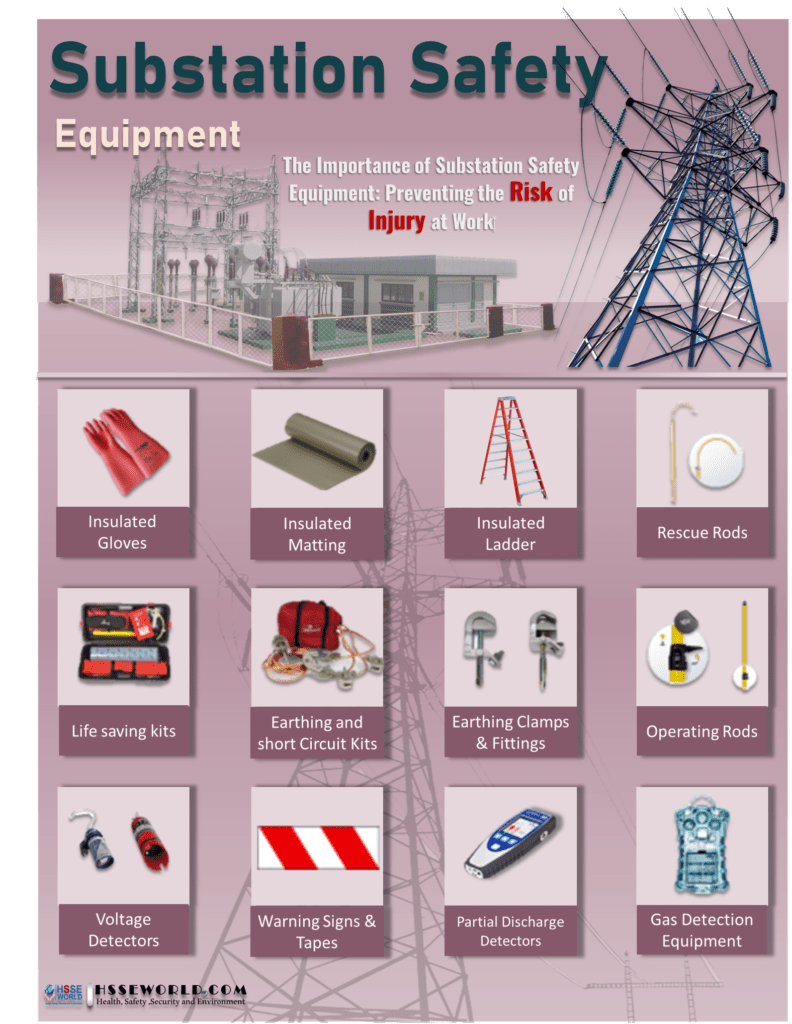Photo of the day: Substation Safety Equipment
Reducing the risk of workplace injuries is a high priority among industries, and is especially so in the electric power industry ( substation building ). Firms across all sectors are implementing substation safety programs to help employees avoid injury at work. This includes training workers on safe operating practices and equipping them with protective equipment. Operators, engineers, and technicians all risk injury from electrical shock, burns, falls, and cuts. To reduce the risk of injury at work and meet safety regulations, it’s essential to have the right safety equipment on hand. In recent years, industrial engineers have focused more on designing safer manufacturing processes instead of developing new machines that are faster or more compact. The risk of electric shock, fires, explosions, and dust explosions has increased as the process complexity has increased. Therefore, substation designers are required to incorporate safety measures into the design of substations in order to reduce the risks associated with substation operations. The photo of today details some of these safety measures, equipment, and their importance during routine maintenance procedures inside a substation
Also Read: What Should Be in Your First Aid Kit?

What are some of the equipment used to prevent injury in substations?
Substations are primarily used to increase the capacity of electrical grids. They are used to increase or decrease the voltage on the grid between transmission and distribution levels to be used by customers. The design of substations varies depending on the application, but they often consist of voltage transformers, circuit breakers, and ancillary equipment such as surge arrestors, capacitor banks, and breakers for protection devices. In a substation, the voltage can be extremely high—as high as 400 kV (i.e. 400,000 Volts). To reduce the risk of injury from high voltages, workers must wear protective equipment such as rubber gloves, rubber-soled shoes, and full-length clothing. In addition, they must use insulated tools and appliances.
( Also Read: Electrical Substation Safe Accessibility and Required PPE )
Insulated Matting
Insulating matting (dielectric carpets) is designed to protect people and parts of electrical equipment at switchboards, transformers, and other high voltage workplaces.
Greatly decrease the threat of severe injuries caused by electric shocks by furnishing your facility with CLASS 4 Insulating Matting. These dielectric carpets are suitable for installing around transformers and switchboards. When an electric shock occurs, the dielectric carpet protects the individuals standing on it and will not conduct the electrical current. This ensures that they can safely complete their duties. Class 4 Insulated Matting will greatly improve the overall level of safety in any type of HV environment.
Insulated Gloves & Accessories
shall supply a broad range of insulated gloves (also known as dielectric gloves or insulating gloves) from CLASS 00 to CLASS 4. also supply all corresponding accessories including inner mittens, overgloves, and mechanical protection gloves. ( Also Read: How to Choose the Right Safety Gloves 12 Types of Hand Protection Gloves )
Insulated Ladders
shall supply both single rung or double rung insulating stepladders and ladders that conform to EN 131 safety standards.
Working with electricity can be dangerous, at heights even more precautions are required. Insulated ladders can lower the risk while working at heights. If you are on the ground and working on live equipment consider investing in rubber safety mats.
The ladders shall comply with EN 131 safety standards, provide protection up to 30,000 volts, and are constructed from aluminum and dielectric fiberglass.
Rescue Rods
Rescue Rods (also known as Rescue Poles) are commonly used to remove a casualty from an area of danger in rescue operations.
Rescue Rods or poles are intended to remove a person who has been electrocuted from the source of the electricity. The rescue pole is protection for the person rescued by insulating them from any electrical shock. Rescue poles and rods are not designed for use in wet weather or environments.
Voltage Detectors
High voltage detection equipment (HV detectors) is specially designed for the safe and practical detection of voltages on electrical medium and high voltage systems in the power generation and distribution, rail network, petrochemical, and electrical service and maintenance industries.
Life-Saving Kits
The rescue kits have been explicitly designed for Medium Voltage (M.V.) substations and typically include products such as voltage detectors, insulating sticks, rescue hooks, insulating gloves & boots, and safety posters.
Customized Life Saving Kits
Shall also design and supply customized LV and/or MV wall-mounted or Cabinet style Electrical Lifesaving/Rescue Kits. The Lifesaving Kit comes in standard designs.
Standard components include:
- Insulated rescue pole / Shepherd’s hook;
- LV or MV voltage detector with insulated operating rod
- The case for insulating gloves
- 1 pair of LV or MV insulating gloves
- Insulated wire cutter
- Insulated platform or matting
- CPR & Electric Shock Victims Notice
Substation Warning Signs & Tapes
f Warning Tapes, Safety Adhesive Tape, Plastic Chain Delineators, Danger Signs, and First Aid Signs shall be provided and installed at the workplace to prevent and warn unauthorized personnel. ( Also Read:Photo of the day: Floor Marking )
Earthing & Short-Circuiting Kits
shall provide Earthing & Short-Circuiting Kits in the shape of portable earthing kits, railway earthing kits, MV overhead lines earthing kits, and HV overhead lines earthing kits to provide safety to the operator and protect against an accidental voltage return while repair or maintenance to overhead electricity lines is being carried out. The kit complies with IEC 61230 standard and includes MPU clamps made of aluminum alloy, MPUP carrier clamp, PVC insulated copper cables, and much more.
Earthing Clamps & Fittings
Earthing Clamps’ primary function is to connect the earthing cable to the earthing systems connection point. It is imperative that the max. short-circuit currents (Ik /1s) must match the earthing and short-circuiting cables as well as the clamps. Max cross-section: 120mm2, Max short-circuit current: 23,7 lk 1 s (kA), Clamping range: 2mm – 20mm, Clamping width: 38mm, weight: 782g
know How to use Plate Clamps Safely: Safety Moment#34
Gas detection
Gas detection solutions for the protection of plant and personnel from any Gas may be leakead at hazard places such as battery rooms
Electric Shock risk prevention
Electric shock is one of the most common causes of injury in electric power and energy industries. This is caused when the human body comes into contact with a source of electricity that is not properly insulated. When this happens, the current can travel through the body to the ground, causing a serious injury. Electrical injuries can result in death, traumatic injuries, or even long-term disabilities. There are different levels of severity based on the amount of current that passes through the body. Most severe injuries occur when the current is sufficient to cause the heart to stop beating or cause muscle spasms that lead to loss of limb. Burns protection Burns is a leading cause of injury in the power industry. Electrical arcs, sparks, and hot surfaces due to poor ventilation, equipment failure, or human error are all possible causes. For example, when workers are performing maintenance on equipment with faulty insulators, they may come in contact with live parts, causing injuries such as arc burns. Additionally, workers can receive burns from contact with hot transformer oil, electrical equipment, or fluid. While no amount of burns is acceptable, certain types of burns are more serious than others. Electrical burns, flash burns, and burns caused by hot liquids are more likely to be fatal than other types of burns. Electrical burns and flash burns are particularly dangerous because they can cause serious tissue damage very quickly. In these cases, workers should be sent to a hospital immediately because they are at risk of suffering serious, long-term injuries. Life-Saving Kits Life-saving equipment can be used by workers to prevent or treat electrical burns or shocks. One of the most important pieces of life-saving equipment is the rubber insulating gloves, which can be used to safely disconnect equipment with energized conductors. Another important piece of life-saving equipment is a pair of rubber boots, which can be used to step on a “live” conductor without coming into contact with it. Other life-saving equipment includes rubber gloves, rubber boots, and insulated matting. These items can be used to protect workers from touching energized equipment. They can also be used to isolate live equipment from workers. Finally, they can be used to help transport injured workers to safety. ( Read more about Electric Shock and its Psychological Effects )
Download the Photo
Now you can download the Infographic ” Substation Safety Equipment” and post it at the workplace to communicate with everyone to be familiar with the Safety Equipment required at the substation building.
Photo of the day: Substation Safety Equipment
Download more resources at SAFETY BAG


More photos:
- What are the Best Practices for Managing Subcontractor Risk
- Photo of the day: 10 Essential Safety Tips for Driving in Hot Weather Conditions
- Photo of the day: best workplace safety tips
- Photo of the day: The Importance of Stop Work Authority in Maintaining Workplace Safety
- Photo of the day: Tomorrow’s Reward for Working Safely Today: Cultivating a Culture of Safety
- Photo of the day: Preventing slips and trips at work
- Photo of the day: Learn the DRSABCD action Plan
- Working with Electricity Electrical Accidents Guide for Electrical Workers
- Photo of the day: Hearing Protection Device Selection
- Photo of the day: If An Earthquake Shakes You-Infographic free
- Fire Safety Posters Free Download
- Photo of the day: First Aid for Electrical Burns-Infographic free
- Infographic: First Aid for Cuts and Scrapes free download
- Photo of The day: Work Safe with Lasers-Laser Safety free
- Photo of the day: Working Safely with chemicals and chemical Management
- Photo of the day: Safe work practices when using MEWPs ( updated)
- Photo of the day: Preventing Common Kitchen Hazards
- Photo of the day: Safe handling of Gas Cylinders and lecture bottles
- Photo of the day: Forklift Stability Triangle
- Photo of the day: Defective Tools Safe Work Practice
- Photo of the day: Lift With Your Legs Not With Your Back
- Photo of the day: First Aid for burns
- Photo of the day: The 7 Principles of HACCP
- Photo of the day: Working Safely with Suspended Loads
- Photo of the day: Heat Stroke First Aid and safety posters
- Photo of the day: Near-Miss Reporting and Posters
- Photo of the day: Ergonomic chair and office chair safety tips
- Photo of the day: Whole Body Vibration
- Photo of the day: Substation Safety Equipment
- Photo of the day: Bypassing Safety Controls Rules
- Photo of the day: Lightning Safety Tips
- Photo of the day: Overhead Power lines Clearance
- Photo of the day: Floor Marking
- Photo of the day: Types of Foot Protection
- Photo of the day: Types of Hand Protection
- Photo of the day: Lockout and Tagout Safety
- Photo of the day: Fall Protection Plans
- Photo of the day: Flood Safety Tips
- Photo of the day: Read All Labels Work safe
- Photo of the day: Run Project safely with Crane Hand Signals
- Photo of the day: Flagman and Traffic control
- Photo of the day: Managing Risks of Exposure to Solvents in the workplace
- Photo of the day: Scissor Lift Safety
- Photo of the day: HSE Bulletin Board
- Photo of the day: Arc-Fault Circuit Interrupters (AFCI)
- Photo of the day: Safe use of ladders and step ladders
- Photo of the day: Concrete Truck Driver Hand Signals
- Photo of the day: Extension Cord Safety Tips
- Photo of the day: Protect your Head
- Photo of the day: choosing the right Anchorage
- Photo of the day: Work-Related Asthma
- Photo of the day: Top FIVE Heavy Equipment Construction Site Safety Tips
- Photo of the day: sun safety in the workplace
- Photo of the day: Cannabis and Impairment in the Workplace
- Photo of the day: Position for safety and comfort-Safety Tips
- Photo of the day: Generator Safety
- Photo of the day: Controlling COVID-19 in the Workplace-Physical Barriers
- Photo of the day: Manual Material handling
- Photo of the day: Personal Protective Equipment last resort
- Photo of the day: WHMIS 2015 – Pictograms
- Photo of the day: Indoor Air Quality
- Photo of the day: Noise in the affected workplace
- Photo of the day: Fatigue at Work
- Photo of the day: Don’t be Driven to Distraction
- Photo of the day: working in heat and Humidex Rating
- How to use Plate Clamps Safely: Safety Moment#34
- Photo of the day: Sitting at work
- Photo of the day: 5 ways to reduce the risk of Slipping and Tripping
- Photo of the day: Preventing the spread of contagious illness
- Photo of the day: Incident Investigations
- Photo of the day: 10 Scaffold Safety Essentials
- Photo of the day: Effective Health and Safety Committees
- Photo of the day: New worker Orientation & Safety Orientation checklist
- Photo of the day: Workplace Inspection
- Photo of the day: musculoskeletal disorders
- Photo of the day: Emergency preparedness in the workplace
- Photo of the day: Mental health in the workplace
- Photo of the day: Trenching Safety Tips That Can Save a Life
- Photo of the day: Dangerous Goods Classes
- Photo of the day: Safety Equipment for Confined Spaces
- Photo of the day: Tips to reduce Heat stress in the workplace
- Photo of the day: hierarchy of controls
- Your steps to chemical safety
- H2S Gas and how to handle its Emergency
- Photo of the day: Importance of Mock drill and Fire Action Emergency Procedure
- Photo of the day: Choosing the Right Face Mask and the difference between a respirator and face mask
- Photo of the day: Confined space safety Precautions
- Breath Safely: The Proper Use of Respiratory Protection
- Photo of the day: Electric shock survival
- Photo of the day: Chemical Spill Emergency Response
- Photo of the day: Construction Site fire Safety
- Photo of the day: Confined Space rescue
- Photo of the day: Conveyors Safety Tips



